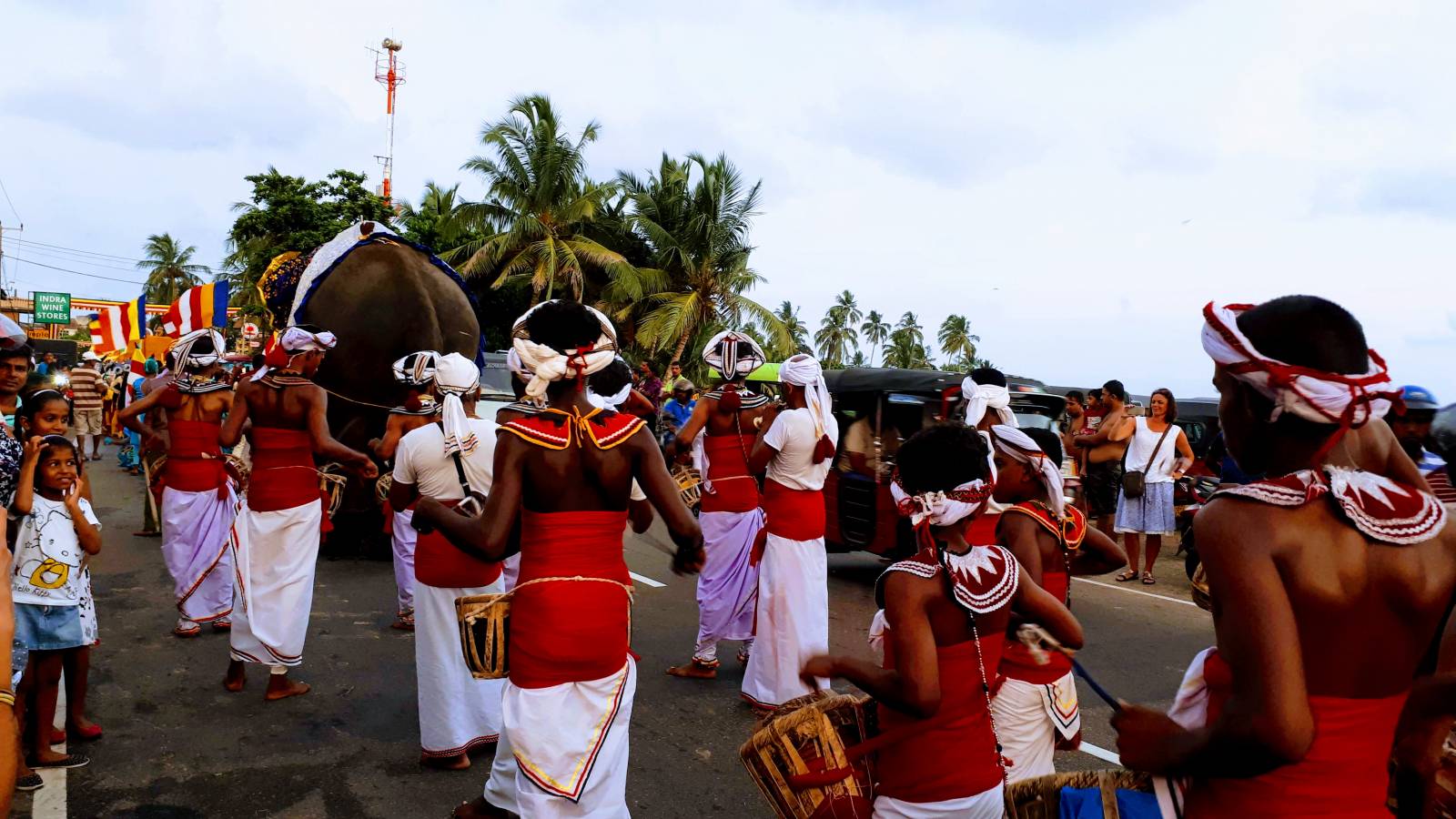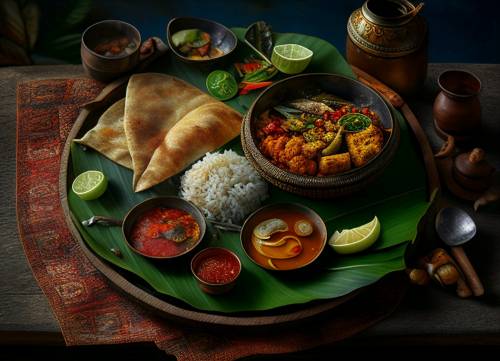Sri Lanka is a land of vibrant and diverse cultures, shaped by the island's unique history, religion, and geography. The country has a rich cultural heritage that dates back thousands of years and is strongly influenced by Buddhism, Hinduism, and Islam, as well as the colonial influences of the Portuguese, Dutch, and British. Sri Lankan culture is known for its hospitality, warm smiles, and welcoming nature, which is evident in the many festivals and ceremonies that take place throughout the year. From the colorful Kandy Esala Perahera to the vibrant Tamil Thai Pongal festival, Sri Lanka's cultural traditions are a reflection of its multi-ethnic and multi-religious society. In this article, we will explore the many facets of culture and traditions, including art, music, dance, food, and clothing. Join us on a journey of discovery as we delve into the fascinating world of Sri Lankan culture.
Sri Lankan cuisine: traditional dishes and flavors
Sri Lankan cuisine is a fusion of flavors and spices that reflect the island's rich history and diverse cultural influences. The traditional dishes are an integral part of culture and are celebrated for their unique blend of spices and flavors. In this article, we will explore some of the most popular local dishes and flavors.
Traditional Sri Lankan Dishes
Local cuisine is known for its use of fresh ingredients and spices. Some of the most popular traditional dishes include rice and curry, string hoppers, hoppers, kottu, and roti. Rice and curry is a staple dish and is made with a variety of curries such as chicken, fish, and vegetable curries. String hoppers are made from rice flour and are a popular breakfast food, served with coconut sambol and dhal curry. Hoppers are a type of pancake made with fermented rice flour and coconut milk, often served with a curry or sambol. Kottu is a popular street food made with shredded roti, vegetables, and meat, cooked on a hot griddle. Roti is a type of flatbread, similar to a tortilla, that is commonly served with curry.
Spices and Flavors
Sri Lankan cuisine is famous for its bold use of spices, which give the dishes their unique flavors. Some of the most commonly used spices include cinnamon, cardamom, cumin, coriander, fenugreek, and fennel. Other spices such as cloves, nutmeg, and saffron are also used in some dishes. In addition to spices, cuisine also uses a lot of coconut, both in the form of coconut milk and grated coconut. Curry leaves and pandan leaves are also commonly used to add flavor to dishes.
Desserts and Drinks
Ceylon cuisine also offers a variety of sweet treats and drinks. Some of the most popular desserts include wattalapam, a sweet pudding made with coconut milk, jaggery, and spices, and kokis, a crispy cookie made with rice flour and coconut milk. Country is also known for its range of fresh fruit juices and smoothies, such as mango lassi and papaya juice. Tea is the national drink of the nation and is world-renowned for its quality. The tea estates in Sri Lanka produce some of the finest teas in the world, and a visit to one of these estates is a must-do for tea lovers.
Sri Lankan cuisine is a unique and flavorful experience that is not to be missed. The blend of spices, fresh ingredients, and cultural influences make Sri Lankan dishes stand out among other cuisines. From the traditional rice and curry to the sweet wattalapam and refreshing fruit juices, there is something for everyone to enjoy in local cuisine.
Festivals and celebrations in Sri Lanka
Festivals and celebrations are an integral part of national culture, and they reflect the country's diversity and rich history. Island has a calendar full of festivals and celebrations, many of which are religious in nature. Here are some of the most notable ones:
Sinhala and Tamil New Year
This festival falls on the 13th and 14th of April every year, and it marks the beginning of the Sinhala and Tamil new year. It is a time for families to come together and celebrate with traditional food, music, and games.
Vesak
Vesak is the most important Buddhist festival in Sri Lanka, and it commemorates the birth, enlightenment, and death of the Buddha. It usually falls in May, and it is celebrated with colorful lanterns, decorations, and processions.
Kandy Esala Perahera
This is one of the most famous festivals in Sri Lanka, and it takes place in the hill capital of Kandy in August. The festival is a 10-day celebration of the sacred tooth relic of the Buddha, and it features vibrant processions with traditional dancers, drummers, and decorated elephants.
Deepavali
Also known as Diwali, this Hindu festival is celebrated in October or November, and it is a time for families to light lamps and candles to symbolize the triumph of light over darkness. It is also a time for feasting and sharing sweets with friends and family.
Christmas
While Sri Lanka is predominantly Buddhist, there is a significant Christian minority, and Christmas is widely celebrated across the country. Churches are decorated with lights and ornaments, and families come together to exchange gifts and enjoy traditional Christmas food.
These are just a few examples of the many festivals and celebrations that take place in Ceylon island throughout the year. Whether you are a religious person or not, these festivals offer a unique opportunity to experience the country's vibrant culture and traditions.
Art and music in Sri Lanka: traditional forms and contemporary influences
Art and music are an integral part of local culture, showcasing the country's rich heritage and traditions. Sri Lanka boasts a diverse range of traditional art forms, including dance, theater, painting, and sculpture, which have been passed down through generations. In recent years, there has been an emergence of contemporary artists who have blended traditional forms with modern influences to create unique pieces of art.
Traditional Art Forms:
Traditional dance and theater are an essential part of the country's cultural identity. Kandyan dance, which originated in the central province, is one of the most popular forms of dance here, characterized by intricate footwork and graceful movements. Meanwhile, low-country dance, which is prevalent in the coastal regions, is a lively and energetic form of dance that incorporates acrobatics and impressive stunts.
Traditional music is dominated by percussion instruments, including the thammattama, a double-headed drum, and the rabana, a hand drum. These instruments are used in various traditional performances, including dance and folk music. Other traditional instruments include the sarangiya, a bowed instrument, and the horanava, a wind instrument.
Contemporary Influences:
Sri Lanka's art scene has seen an influx of contemporary artists who have brought new perspectives and influences to traditional art forms. Many contemporary artists blend traditional techniques and motifs with modern mediums, such as digital art, graffiti, and street art.
Similarly, Sri Lankan music has seen a fusion of traditional forms with contemporary influences, resulting in the emergence of new genres such as baila, a popular dance music style that originated in the Portuguese-influenced regions. In recent years, Sri Lankan musicians have also gained international recognition, with artists such as M.I.A. and Mathangi "Maya" Arulpragasam, who incorporate their heritage into their music.
Sri Lankan dance forms: history and significance
Country is known for its diverse and vibrant cultural heritage, which includes a variety of traditional dance forms that have been practiced for centuries. These dance forms, each with its unique style and significance, are an essential part of artistic heritage and are still performed at religious and cultural festivals across the country.
Origins and History:
The history of Sri Lankan dance forms can be traced back to ancient times, with influences from Indian and Southeast Asian traditions. These dance forms were initially performed as a form of worship to deities and as a means of storytelling. Over time, they evolved into more complex and stylized performances, becoming a form of entertainment as well as a way to preserve cultural heritage.
Traditional Dance Forms:
There are several traditional dance forms, each with its unique style, costumes, and music. The Kandyan dance is perhaps the most well-known and is characterized by its graceful movements and elaborate costumes. Other popular dance forms include the Sabaragamuwa dance, which originated in the Sabaragamuwa province and the Low Country dance, which is known for its fast-paced rhythms and acrobatic movements.
Significance and Modern Influences:
Sri Lankan dance forms are more than just entertainment; they are an important part of the country's cultural identity. They serve as a means of preserving cultural heritage and are a way to connect with the past. In recent years, there has been an effort to modernize these dance forms while still maintaining their traditional essence. Contemporary choreographers have incorporated modern techniques and music into these dances, making them more accessible to younger generations.
Overall, dance forms are a significant aspect of the country's cultural heritage, and their unique styles and significance have captured the attention of many visitors. By experiencing these performances firsthand, tourists can gain a deeper understanding and appreciation for the rich cultural traditions.
Traditional clothing and attire in Sri Lanka
Traditional clothing and attire hold a special place in the country's culture and history. The clothing reflects the diversity and richness of the various ethnic groups that call Sri Lanka their home. Here are some key points about traditional clothing and attire:
Sarong: A sarong is a long piece of cloth that is wrapped around the waist and worn as a skirt. It is the most commonly worn traditional attire for men and women in the country. The fabric used for sarongs varies from region to region, with cotton being the most popular choice.
Saree: The saree is a long piece of cloth draped around the body and is worn by women. It is a traditional garment that has been worn for centuries and is still popular today. The saree comes in a variety of colors and materials, and the way it is draped varies from region to region.
National dress: Sri Lanka's national dress for women is the Kandyan saree, which features a long, flowing skirt and a jacket with intricate embroidery. For men, the national dress is a white shirt and sarong.
Traditional headwear: Women often wear a traditional headscarf called a petha, while men may wear a turban or a cap.
Significance of colors: Colors play an important role traditional clothing. White is considered a symbol of purity and is often worn by Buddhist monks. Red is associated with power and is worn during special occasions, while gold and silver are considered auspicious and are used in ceremonial attire.
Traditional clothing is still widely worn today, particularly during religious and cultural events. The attire not only reflects the country's rich heritage, but also adds a unique and colorful element to cultural landscape.
Religion in Sri Lanka: coexistence of Buddhism, Hinduism, Islam and Christianity
Religion is an integral part of Sri Lankan culture and society, and the country is home to a diverse range of religions. The predominant religion is Buddhism, with over 70% of the population identifying as Buddhist. Hinduism, Islam, and Christianity are also practiced by significant minority populations.
Buddhism arrived in the third century BCE, and it has played a significant role in shaping Sri Lankan culture and society ever since. Buddhist temples, or viharas, are scattered throughout the country and are a common sight in almost every town and village. Ceylon is also home to many important Buddhist sites, including the ancient city of Anuradhapura, which was the capital of Sri Lanka for over a thousand years.
Hinduism arrived around the same time as Buddhism and has had a significant influence on culture. Hindu temples can be found throughout the country, with the most famous being the Nallur Kandaswamy Kovil in Jaffna. The annual Vel festival, which celebrates the Hindu god Murugan, is one of the biggest events in the Hindu calendar and attracts thousands of devotees from across the country.
Islam arrived in the eighth century, and the country is home to a significant Muslim population, particularly in the eastern and northern regions.
Christianity arrived with the arrival of European colonial powers in the 16th century. Today, Christianity is practiced by a minority of Sri Lankans, with the majority of Christians being Roman Catholic. The most famous Christian site is the St. Anthony's Shrine in Kochchikade, which attracts pilgrims from across the country.
Despite the diversity of religions, the different religious communities generally coexist peacefully. Many Sri Lankans practice a syncretic form of religion that blends elements of different religions together, and it is not uncommon to see Buddhist temples, Hindu kovils, and Christian churches coexisting in close proximity to one another.
Traditional healing practices in Sri Lanka
Traditional healing practices have been an integral part of culture for centuries. These practices are deeply rooted in Ayurveda, the ancient system of medicine that originated in India and has been practiced in Sri Lanka for over 2,500 years. Ayurveda emphasizes the use of natural remedies and therapies to maintain health and balance in the body, mind, and spirit. Here are some of the traditional healing practices you can experience in Sri Lanka:
Ayurvedic treatments
Ayurveda offers a wide range of treatments that include herbal medicine, massages, and other therapies to promote healing and rejuvenation.
Herbal medicine
Ceylon has a rich tradition of using herbs and plants to treat various ailments. These remedies are often made from locally grown herbs and plants and are used to treat a range of conditions, from digestive issues to skin problems.
Yoga and meditation
Yoga and meditation are practiced widely and are seen as powerful tools for healing and spiritual growth. Many Ayurvedic centers and spas offer yoga and meditation classes to help promote physical and mental well-being.
Traditional medicine
Sri Lanka has a long history of traditional medicine practices that are based on local knowledge and experience. These practices often involve the use of herbs, plants, and other natural remedies to promote healing.
Spiritual healing
Sri Lanka is a deeply spiritual country, and many traditional healing practices are based on spiritual beliefs and practices. Spiritual healers, such as Buddhist monks or Hindu priests, offer blessings and prayers to promote healing and well-being.
Traditional healing practices offer a unique and holistic approach to health and well-being. These practices are deeply rooted in the country's culture and offer a window into the rich history and traditions of the island.
Sri Lankan architecture: history and styles
The country's architecture has been influenced by various styles and has evolved over time. Here, we will explore the history and styles of Sri Lankan architecture.
History of architecture
Sri Lankan architecture has its roots in ancient times. The country's ancient kingdoms, such as Anuradhapura and Polonnaruwa, left behind magnificent structures that still stand today. These structures were built using materials such as stone, brick, and wood. They are characterized by intricate carvings and details that depict the culture and beliefs of the time.
Styles of architecture
Architecture is diverse and has been influenced by various styles. Some of the styles that have influenced Sri Lankan architecture are Indian, Southeast Asian, and European. Here are some of the most notable styles:
Sinhalese architecture: This style is unique to Sri Lanka and is characterized by intricate carvings and details that depict Buddhist and Hindu beliefs. The structures are typically made of brick and stone and are adorned with beautiful carvings.
Dravidian architecture: This style originated in South India and has been used for centuries. It is characterized by pyramidal towers, called gopurams, which are adorned with intricate carvings.
Colonial architecture: Sri Lanka was colonized by the Portuguese, Dutch, and British, and their influence can be seen in the country's architecture. Colonial architecture is characterized by its use of brick and stone, and its large, imposing structures.
Modern architecture: In recent years, Sri Lanka has seen an increase in modern architecture. This style is characterized by its use of concrete, steel, and glass.
Architecture is a reflection of the country's rich cultural heritage. The history and styles of architecture are diverse and have been influenced by various cultures. From ancient kingdoms to modern structures, Sri Lankan architecture is a testament to the country's past and present.
Sri Lankan folklore and mythology: tales and beliefs
Ceylon has a rich history of folklore and mythology that dates back thousands of years. These tales and beliefs have been passed down through generations and have become an integral part of culture. From mythical creatures to ancient gods and goddesses, folklore and mythology offer a glimpse into the country's colorful past.
Legends of Folklore
One of the most famous Sri Lankan folktales is the story of "Katharagama Deviyo." This legend tells of a god who was born out of a lotus flower and became the protector of the island. He is worshiped by both Buddhists and Hindus and is believed to bring prosperity and good fortune to those who seek his blessings.
Another popular folktale is the story of "Kinnara and Kinnari," two half-bird, half-human creatures who are known for their musical abilities. According to the legend, the Kinnari would sing and dance while the Kinnara played the "vina," a traditional Sri Lankan instrument.
Mythical Creatures
Island is home to a variety of mythical creatures, some of which are believed to be protectors of the land. The "yakka," for example, is a demon-like creature that is said to reside in caves and forests. While some yakkas are considered malevolent, others are believed to be benevolent and are worshipped by locals.
Another mythical creature is the "garuda," a bird-like creature that is often depicted in Hindu and Buddhist mythology. The garuda is said to be the mount of the god Vishnu and is believed to be a symbol of power and freedom.
Beliefs and Superstitions
Many Sri Lankans still believe in ancient superstitions and traditions that have been passed down through generations. For example, some believe that walking under a coconut tree during a full moon can lead to bad luck, while others believe that placing a statue of a frog in the home can bring prosperity.
The practice of astrology and palm reading is also popular, with many seeking advice from local astrologers for everything from career advice to marital problems.
Folklore and mythology offer a fascinating insight into the country's history and traditions. From mythical creatures to ancient gods and goddesses, these tales and beliefs have become an integral part of culture and continue to be passed down through generations. Whether you're a believer or not, exploring these legends and stories is a great way to gain a deeper understanding and appreciation of Sri Lanka's rich cultural heritage.






